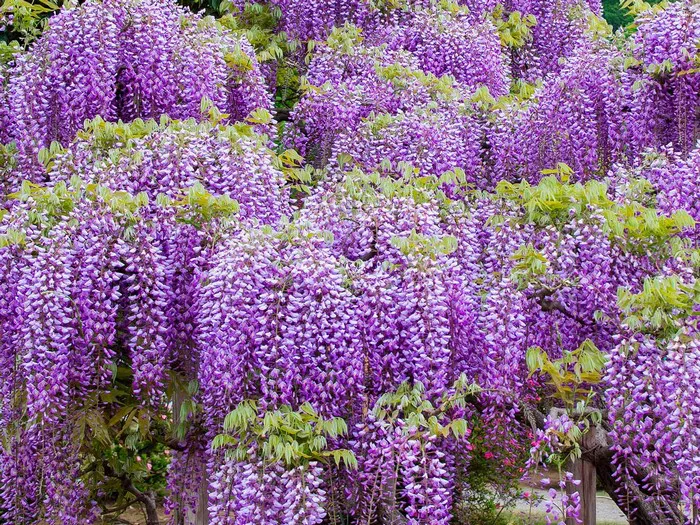Wisteria, with its cascading blooms of lavender, blue, pink, or white, can transform any garden into a scene of enchantment. However, for many gardeners, coaxing these captivating vines to flower can be a challenge. Understanding the intricacies of wisteria care and providing the optimal conditions are essential for encouraging prolific blooming. In this article, we delve into the world of wisteria cultivation, offering expert tips and insights to help you unlock the secret to abundant flowering.
Understanding Your Wisteria: Varieties and Characteristics
Before delving into the specifics of encouraging flowering, it’s crucial to understand the type of wisteria you’re dealing with. There are several species of wisteria commonly grown in gardens, but the two most popular are Wisteria sinensis (Chinese wisteria) and Wisteria floribunda (Japanese wisteria). Each variety has its own unique characteristics and requirements.
Chinese wisteria, known for its vigorous growth and fragrant flowers, typically blooms in late spring or early summer before leafing out. Japanese wisteria, on the other hand, often blooms later in the season and boasts longer flower clusters. Additionally, there are cultivars within each species that may exhibit variations in flowering time, color, and growth habit.
The Importance of Proper Pruning
Pruning plays a pivotal role in encouraging wisteria to flower. Without regular pruning, these vines can quickly become rampant and overgrown, focusing their energy on foliage rather than flowering. The key to successful pruning lies in striking a balance between maintaining the plant’s desired shape and stimulating flower production.
Begin by pruning your wisteria in late winter or early spring while the plant is still dormant. Remove any dead, damaged, or crossing branches to improve air circulation and reduce the risk of disease. Next, selectively prune back lateral shoots to approximately 2 to 3 buds from the main framework of the plant. This encourages the development of flowering spurs and prevents the vine from becoming overly congested.
Throughout the growing season, continue to monitor your wisteria and prune as needed to keep it in check. Avoid heavy pruning after midsummer, as this can remove potential flower buds for the following year. With regular, strategic pruning, you can train your wisteria to produce an abundance of blooms year after year.
Providing Optimal Growing Conditions
In addition to proper pruning, providing your wisteria with the optimal growing conditions is essential for promoting flowering. Wisteria thrives in full sun and well-drained soil with a slightly acidic to neutral pH. Plant your wisteria in a location where it will receive at least six hours of direct sunlight per day, ensuring adequate exposure for robust growth and flowering.
When planting wisteria, amend the soil with organic matter such as compost or well-rotted manure to improve fertility and drainage. Water newly planted wisteria regularly to establish a strong root system, then gradually transition to a more moderate watering schedule once the plant is established. Avoid overwatering, as this can lead to root rot and other moisture-related issues.
In regions with mild winters, wisteria may benefit from a layer of mulch applied in late fall to insulate the roots and conserve moisture. Mulching also helps suppress weeds and maintain consistent soil temperatures, creating an ideal environment for healthy wisteria growth.
Fertilizing for Flower Production
While wisteria is relatively low-maintenance, occasional fertilization can provide the extra boost needed to encourage flowering. Apply a balanced fertilizer with a formulation such as 10-10-10 in early spring before new growth emerges. This supplies essential nutrients such as nitrogen, phosphorus, and potassium, which are vital for overall plant health and flower production.
Avoid excessive fertilization, as this can lead to lush vegetative growth at the expense of flowering. Instead, aim for a moderate application of fertilizer once per year, adjusting the dosage based on soil conditions and the specific needs of your wisteria.
Overcoming Common Challenges
Despite your best efforts, you may encounter challenges along the way that hinder your wisteria’s ability to flower. Pests such as aphids, scale insects, and caterpillars can sometimes infest wisteria vines, causing damage to foliage and flowers. Monitor your plants regularly for signs of pest activity, and intervene promptly with appropriate control measures such as insecticidal soap or horticultural oil.
Diseases such as powdery mildew, leaf spot, and crown gall can also afflict wisteria, compromising its overall health and vigor. To minimize the risk of disease, practice good sanitation by removing fallen leaves and debris from around the base of the plant. Additionally, avoid overhead watering, which can promote fungal growth and spread disease.
In colder climates, late frosts can damage emerging flower buds, resulting in reduced or delayed flowering. To protect your wisteria from frost damage, cover the plant with a lightweight fabric or sheet when freezing temperatures are forecasted. Alternatively, consider planting wisteria in a sheltered location or against a south-facing wall to provide added warmth and protection.
Conclusion
Achieving a profusion of blooms on your wisteria requires a combination of proper care, diligent maintenance, and patience. By understanding the specific needs of your wisteria variety, implementing regular pruning and fertilization, and providing optimal growing conditions, you can encourage abundant flowering and enjoy the breathtaking beauty of these iconic vines in your garden.
Unlocking the secret to wisteria flowering is a rewarding journey that allows you to cultivate a garden masterpiece that will captivate the senses and inspire admiration for years to come. With dedication and attention to detail, you can transform your wisteria into a spectacle of color and fragrance that will leave a lasting impression on all who behold it.

